Don't wanna be here? Send us removal request.
Text
International Role of Georgia and Georgian Money
Tedo Dundua
For millennia Georgia has been delivering tremendous services to Europe as European frontier and to international commerce as a bridge to Asia. Coins issued in Georgia facilitated both, defence and trade. Defence and trade shaped themselves as international issues, thus these coins are mostly bilingual. Even now the Georgian money is bilingual. There are several samples below.
Coins with the depiction of cross on altar. Stephanos I, prince of Kartli/Iberia (East and South Georgia). Last decade of the 6th c.
Obverse: Ohrmazd IV (Sassanid shah) to the right. Inscription in Pehlevi: hrm – aphzu (Ohrmazd Augustus). This is placed within onefold circle of the dots. Four Georgian letters (Asomtavruli) on the edge of the coin for the name of Stephanos, with four crescents on the sides. Reverse: Cross on altar protected by two guardians. Date and name of the mint are unreadable, all placed within twofold circle of the dots.
http://geonumismatics.tsu.ge/en/catalogue/types/?type=33
St. Virgin Blachernitissa type coins. Bagrat IV, king of Georgia (1027-1072).
Obverse: Facing bust of Virgin orans, nimbate, wearing pallium and maphorium. Greek legend – the Holy Virgin, close to nimbus, in different ways. Reverse: Marginal Georgian legend – Christ, exalt Bagrat, king of the Abkhasians (i.e. the Western Georgia). In the center – and Sebastos.
http://geonumismatics.tsu.ge/en/catalogue/types/?type=42
Coins of Giorgi III, king of Georgia (1156-1184) – king with falcon on hand.
Obverse: Giorgi III in Asian-Byzantine dress. Seated cross-legged, facing. His left (sometimes right) hand rests on his thigh, on another hand up lifted sits a falcon. King wears stemma. Georgian Mkhedruli letters for the name of Giorgi (sometimes Georgian Asomtavruli monogram is added to it) and Asomtavruli legend, in the K’oronikon 394 (=1174). Reverse: Arabic legend in three lines – King of the Kings Giorgi, son of Demetre, sword of the Messiah.
http://geonumismatics.tsu.ge/en/catalogue/types/?type=66
Copper coins of Erekle II, king of East Georgia (1745-1798) – with the effigy of eagle.
Obverse: Georgian Asomtavruli legend in abbreviation for the name of Erekle. Below, Persian legend – Struck at Tbilisi, and date 1210 (=1795/1796).
Reverse: Eagle. Below, date 1796.
http://geonumismatics.tsu.ge/en/catalogue/types/?type=115
Russo-Georgian coins struck at Tbilisi in 1804-1834 with the effigy of crown.
Obverse: Crown, palm and olive branches. Georgian legend – Tbilisi. Reverse: Georgian legend – 100/Georgian/tetri/1805. Russian legend, initials of die-engraver.
http://geonumismatics.tsu.ge/en/catalogue/types/?type=120


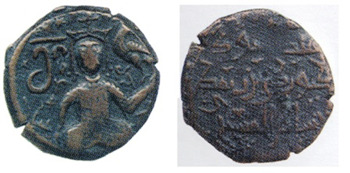
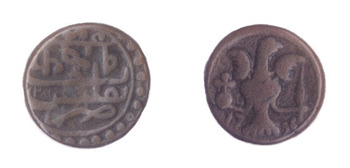

0 notes
Text
Georgia’s Fully Convertible Currencies
Tedo Dundua
Now Georgia has lari, partially convertible currency, not for large international transactions. Historically too, coins struck in Georgia served the local market, only some issues being involved in international trade. Findings of Georgian numismatic data outside the country attest to this fact.
Colchian (Western Georgian) II type didrachm (5th c. B.C.) was found on archaeological site of Hermonassa, Ancient Greek colony (Taman Peninsula, Russia).
http://geonumismatics.tsu.ge/en/catalogue/types/?type=9
Colchian (Western Georgian) II type hemidrachms (5th-3rd cc. B.C.) were found on archaeological site of Nymphaion, Ancient Greek colony (Crimea, Ukraine).
Colchian II type hemidrachms were found in Central Asia.
http://geonumismatics.tsu.ge/en/catalogue/types/?type=13
Stater of Colchian king Aka (beginning of 2nd c. B.C.) was found in Trabzon (Turkey).
http://geonumismatics.tsu.ge/en/catalogue/types/?type=6
Only four specimens are known from the issue (979) of David III Kuropalates, ruler of Southwestern Georgia. From the 4 silver specimens none of them was found in Georgia. They were discovered far away from there, in Russia, Estonia, Germany and Sweden (Near St. Petersburg, place Lodeinoe Pole, Russia; place Völlja, Estonia; Mecklenburg-Schwerin, place Schwaan, Germany; Gotland, Dalhem, Hallfose II, Sweden).
http://geonumismatics.tsu.ge/en/catalogue/types/?type=40
There are numerous findings of coins of Tamar (1184-1210) and Rusudan (1223-1245), queens of Georgia, in Armenia and Azerbaijan. http://geonumismatics.tsu.ge/en/catalogue/types/?type=70
http://geonumismatics.tsu.ge/ge/catalogue/types/?type=74
Coin below is sirma vertskhli (silver) of Erekle II (1745-1798), king of Eastern Georgia, with the Persian inscriptions. Due to high fineness, these coins were in circulation for a long time not only in Georgia, but also in Armenia and Azerbaijan. Nukha khanate in Azerbaijan imitated sirma vertskhli, as well as governor of the Georgian king in Ganja during its occupation (1786-1791). Indeed, sirma vertskhli was very much popular.
http://geonumismatics.tsu.ge/en/catalogue/types/?type=119

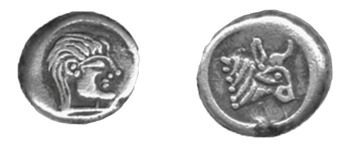




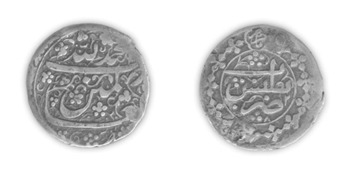
1 note
·
View note
Text
European Mints for Georgian Money
Tedo Dundua
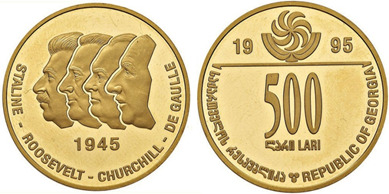
Georgia’s fruitful relations with the West have also “financial” history. On April 9, 1991 the Supreme Council of Georgia declared an independence of the country. National Bank of Georgia was established on August 2, 1991. Since October 2, 1995 lari, national currency of Georgia, has been in circulation. This was a revival of national minting tradition, having the 6th c. B.C. as a starting point.
Alas, with no technologies left by the Soviets, Georgians had to order to Western companies both, banknotes and commemorative coins. For example, banknotes dated by 1995 and commemorative gold coin dedicated to the 50th anniversary of victory in the World War II were produced by French company “François Charles Oberthure”, according to the Georgian design. In 2000 National Bank of Georgia ordered to the Royal Mint, UK, silver, copper-nickel alloy and bimetallic coins dedicated to 2000 A.D. and 3000 years of Georgian statehood.
https://www.academia.edu/31559754/Money_in_Georgia._Tbilisi._2003
Collaboration of the same type existed in the past. Not because they lacked mint technologies, but for higher level of Greek art, some of Georgian (Colchian and Iberian) rulers ordered their coins to be struck in bilingual (Graeco-Colchian) cities of Phasis (Modern Poti, Western Georgia) or Trapezus (Modern Trabzon, Turkey).
Coin evidence and narrative clearly demonstrate that throughout the second half of the 3rd c. B.C. Bagrat Pharnavaziani, duke of Klarjeti (Southwest Georgia), issued the coins with the proud Aramaic legend. Saurmag, the second king of Iberia (East, South and Southwest Georgia), had to deal with a revolt of the dukes. Was ambitious Bagrat among them, did he secure southern principality for himself? Perhaps, we need more records for the full picture. But still, his coins are present, ordered, maybe, to the nearest Greek community. And that could be either Phasis, or Trapezus.
https://www.academia.edu/18919088/Online_English-Georgian_Catalogue_of_Georgian_Numismatics
Aka stater is exact copy of the gold coins struck with the name of Lysimachus (after his death), Alexander’s general. Aka stater was issued in the beginning of the 2nd c. B.C. Two specimens are known. Stylistically, technically and artistically the coin is no less than its prototype. Topography of the coin findings proves their local, Colchian origin – they were found in Trabzon/Trapezus and in Western Georgia. Name of the king on reverse of the coin is in possessive case and can be translated (from the Greek) as “of king Akes/Aka or Akos”.
https://www.academia.edu/18919088/Online_English-Georgian_Catalogue_of_Georgian_Numismatics
Thus, Georgia’s Western affiliation can be traced every time in every sphere of life.

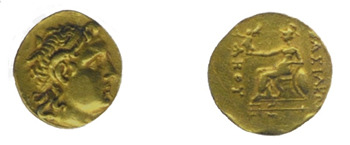
0 notes
Text
Euro-Asian Transit and Georgian Finances
Tedo Dundua
Georgia, an extremely busy commercial bridge to Asia, has been permanently involved in big projects, funded by both, European and Asian financial organizations. In the past times, being absolutely integrated with Europe, Georgians also kept careful watch on the economies of Asian countries, to answer the challenges.
The 12th c. saw most amazing financial challenge. Middle Eastern countries stopped to issue silver coins (“silver famine”). Silver bullions kept in state coffers still made the prices, but only copper money was in circulation. Ratio of silver to copper was at least 1 to 10, i.e. copper coins total weight could be 10 times more, flooding the markets.
That is why, everyone agreed about new ratio, perhaps, 1 to 6, thus making their copper issues acceptable abroad. Georgians did the same. Their “irregularly” struck copper coins have also Arabic legends/inscriptions. Here are the samples.
Georgian coin before “silver famine”.
St. Virgin Blachernitissa type coins – David IV’s (1089-1125) second emission. Silver.
Obverse: Facing bust of Virgin orans, nimbate, wearing pallium and maphorium. Greek legend ΜΡ – ΘΥ, to l. and r. from nimbus. Reverse: Cross in the center and marginal Georgian legend – “Christ, exalt David, the king and Sebastos (?)”.
http://geonumismatics.tsu.ge/en/catalogue/types/?type=47
Georgian coin during “silver famine”.
Coins of queen Tamar (1184-1210) with her signature. “Irregularly” struck copper. Obverse: Signature of Tamar in the center of a wreathed frame. Marginal Georgian legend – In the name of God, this silver (!) piece was struck in the K’oronikon 407 (=1187). Reverse: Arabic legend in five lines –The great queen, glory of the world and faith, Tamar, daughter of Giorgi, champion of the Messiah, may God increase her victories. Circle around and marginal Arabic legend – May God increase her glory, and lengthen her shadow, and strengthen her prosperity.
http://geonumismatics.tsu.ge/en/catalogue/types/?type=68
Coins of Giorgi IV (1210-1223) with the legend “Giorgi, son of Tamar”. “Irregularly” struck copper. Obverse: Georgian legend in the center of a wreathed frame – Giorgi, son of Tamar. Marginal Georgian legend – In the name of God, this silver (!) piece was struck in the K’oronikon 430 (=1210). Reverse: Arabic legend in four lines – King of the Kings, glory of the world and faith, Giorgi, son of Tamar, sword of the Messiah. Circle around. Persian legend outside the circle –In the name of the most saint God this silver piece was struck in the year 430.
http://geonumismatics.tsu.ge/en/catalogue/types/?type=71
Georgian coin after “silver famine”.
Silver coins of queen Rusudan (1223-1245) with the effigy of Christ. Obverse: Bust of Christ facing, wearing nimbus, pallium and colobium and raising right hand in benediction, holds ornamented book of Gospels in left hand. Greek legend: ΙC ΧC. Marginal Georgian legend – in the name of God, was struck in the K’oronikon 450 (=1230). Reverse: In the center of an ornamented frame three Georgian letters for the name of Rusudan. Marginal Arabic legend – Queen of the Queens, glory of the world and faith, Rusudan, daughter of Tamar, champion of the Messiah.
http://geonumismatics.tsu.ge/en/catalogue/types/?type=49



0 notes
Text
Liberties and Phrygian Caps in Georgia
Tedo Dundua

Some common European symbols were in usage for millennia. Central figure on reverse above is pileus, a cap of emancipated slaves in Rome, i.e. symbol of liberty. Following the assassination of Caesar, M. Iunius Brutus used this symbol to declare end of the tyranny.
Mithras, Graeco-Roman god of Persian origin, god of the sun, light and justice, wears a Phrygian cap. That means as follows: pileus was often confused with Phrygian cap, latter also becoming a liberty cap.
French revolution, in its turn, maintained this confusion, taking Phrygian cap as symbol of liberty.
Mithras as equestrian on the municipal copper coins of bilingual (Graeco-Colchian/Western Georgian) Trapezus under the Roman rule wears a Phrygian cap.
http://geonumismatics.tsu.ge/en/catalogue/types/?type=26
Next are the municipal copper coins of Dioscurias in Colchis (modern Sokhumi, Western Georgia) with the effigies of Dioscuri’s caps and thyrsus. Typologically the coins are connected to the municipal copper coins of Pontus – obverse type (two Phrygian caps) is taken from Amisus’ coins, issued in 120-111 B.C., and reverse type (thyrsus) is borrowed from municipal numismatics of South and North Black Sea coasts, from the coins struck in 105-90 B.C. Coins issued in Dioscurias should be undoubtedly dated back to the end of 2nd c. B.C. and the beginning of the 1st c. B.C. Accordingly, Mithridates VI, king of Pontus, annexed East Black Sea coast exactly in those times. Dioscurians, now subjugated to Mithridates, restored their diminished municipal structures, and struck their own copper money with the “caps of liberty”. Still, Mithridates’ garrison was located in Dioscurias and the official appointed by him controlled the mint.
http://geonumismatics.tsu.ge/en/catalogue/types/?type=22
Thus, like everywhere in Europe, in Georgia (Colchis and Iberia) the Phrygian caps meant liberty.


3 notes
·
View notes
Text
Democracy in Georgia: Past and Present
Tedo Dundua
Georgia, the most successful country in democracy building, enclosed small republics in ancient times. They were bilingual (Graeco-Colchian) Phasis (modern Photi) and Dioscurias (modern Sokhumi) at the East Black Sea coast.
Apollo was main deity of Phasis, according to records and numismatics. Lion, symbol of Apollo, is depicted on the local coins.
Obverse: Lying hermaphrodite lion to the right/left with a head turned back. Reverse: Kneeling female figure with a bull’s head to the right/left in quadratum incusum. http://geonumismatics.tsu.ge/en/catalogue/types/?type=4
This is Colchian (Phasian) didrachm, struck in the 5th c. B.C. Lion is depicted also on other denominations. Hermaphroditization is a result of Apollo’s merge with the local female sun. In 1899 near the Kuban river in Zubovka village a silver cup with the following inscription was found: “I belong to Apollo-Hegemon, who is in Phasis”. The inscription dates to the 5th c. B.C., or the beginning of the 4th one. All the scholars unanimously agree that the cup was dedicated to the Apollo’s temple which presumably existed in Phasis. Although lions depicted on Colchian (Phasian) coins are most undoubtedly associated with the Apollo cult, we should not forget that the main deity of the Georgian pagan pantheon was the sun. Lion is generally considered as the sun’s symbol. At the same time, in the beliefs of the Georgians, the sun is considered as female. If we remember that a hermaphrodite lion is depicted on Colchian didrachm, then it is possible to propose hypothesis: did the Greeks strike the coin type with the obverse depiction meeting the two ethnic groups’ (Colchian and Greek) interests, because the depiction of lion is semantically linked to Apollo and one of the main deities of the Georgians – the sun.
When city has Apollo as main deity, it is oligarchic. Phasis was oligarchic republic.
In the 5th-3rd cc. B.C. Phasis issued the hemidrachms below: Obverse: Archaic female head to right/left within the linear circle or in border of the dots. Reverse: Bull’s head to right within the linear circle. Some of the coins are with the Greek letters – ΜΟ/ΣΟ, Φ, Α, Ο, Ε, Π, Δ. http://geonumismatics.tsu.ge/en/catalogue/types/?type=13
Athens, a fashion maker, still preserved archaic style on the coins until the 2nd c. B.C., thus demonstrating its democratic conservatism. Archaic style on Colchian (Phasian) money, does it mean the same, i.e. fidelity to republican constitution until the 3rd c. B.C.?
When city has symbols of Dionysus on the coins, it could be democratic, even formally.
Municipal copper coins of Dioscurias (105-90 B.C.).
Obverse: Caps of Dioscuri, surmounted by six, or eight-pointed stars. Reverse: Thyrsos of Dionysus in the center of the coin, the Greek three-line legend on both sides ΔΙΟΣ/ΚΟΥΡΙΑ/ΔΟΣ.
http://geonumismatics.tsu.ge/en/catalogue/types/?type=22
Dioscurians, subjugated to Mithridates VI, king of Pontus, preserved their municipal structures and struck their own copper money. Also, it seems that Mithridates’ garrison was located in Dioscurias and official appointed by him controlled the mint.



0 notes
Text
Universal Styles of Clothing on Georgian Money
Tedo Dundua
Europe and Asia, two principal zones of integration, had their universal changeable styles in architecture, clothing etc. When affiliated to Hellenistic Orient, Georgians were dressed in Persian-style clothing. When affiliated to “Byzantine Commonwealth” (East European world), Georgians were dressed in Byzantine-style clothing. Modern Georgia means Modern Style. The whole story is depicted on Georgian money.
a) Georgians dressed in Persian-style clothing.
Coins of Bagadat, son of Biurat, duke of Klarjeti (Southwest Georgia). I type. Second half of the 3rd c. B.C
http://geonumismatics.tsu.ge/en/catalogue/types/?type=16
Coins of Bagadat, son of Biurat, duke of Klarjeti (Southwest Georgia). II type. Second half of the 3rd c. B.C
http://geonumismatics.tsu.ge/en/catalogue/types/?type=17
b) Georgians dressed in Byzantine-style clothing.
David IV’s (king of Georgia) copper coin, type – king in Imperial coat. 1118-1125.
http://geonumismatics.tsu.ge/en/catalogue/types/?type=48
Coins of Giorgi IV (king of Georgia) – king in Imperial dress. 1210.
http://geonumismatics.tsu.ge/en/catalogue/types/?type=73
Coins with the effigy of two Davids (David Ulugh and David Narin, kings of Georgia). 1261-1262.
http://geonumismatics.tsu.ge/en/catalogue/types/?type=98
c) Georgians dressed in Modern clothing.
Lari. National currency of Georgia.
https://www.academia.edu/31559754/Money_in_Georgia._Tbilisi._2003

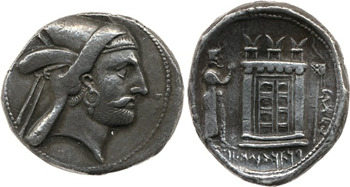




0 notes
Text
Fashion on Georgian Money
Tedo Dundua
Wearing or shaving the facial hair has been more a matter of fashion, than something else. Georgians favoured beard and mustache during the whole Feudal period as seen in coinage.
Coins of Bagadat, son of Biurat, duke of Klarjeti (Southwest Georgia). Second half of the 3rd c. B.C. (Obverse: Head of Bagadat, bearded, with moustache).
http://geonumismatics.tsu.ge/en/catalogue/types/?type=16
David IV’s (king of Georgia) copper coin, type – king in Imperial coat. 1118-1125 (Obverse: Bust of bearded king in Imperial coat).
http://geonumismatics.tsu.ge/en/catalogue/types/?type=48
Coins of Giorgi III (king of Georgia) – king with falcon on hand. 1174 (Obverse: Bearded king in Asian-Byzantine dress).
http://geonumismatics.tsu.ge/en/catalogue/types/?type=66
Coins of Giorgi, king of Imereti (Western Georgia). I type. 1565-1585 (Obverse: head of bearded man in jewelled crown).
http://geonumismatics.tsu.ge/en/catalogue/types/?type=84
Like everywhere in Europe, beard and mustache were beloved in Georgia in the second half of the 19th c.-beginning of the 20th c. Prominent figures of this period are represented now on the Georgian banknotes (Niko Pirosmani, painter (1 lari), Zacharia Paliashvili, composer (2 lari), Ivane Javakhishvili, historian (5 lari), Akaki Tsereteli, poet (10 lari), Ilia Chavchavadze, writer and political figure (20 lari), Kaikhosro (Kakutsa) Cholokashvili, military officer and national hero (200 lari).
https://www.academia.edu/31559754/Money_in_Georgia._Tbilisi._2003

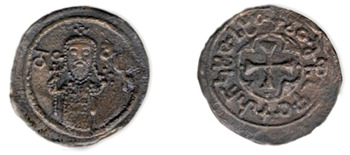

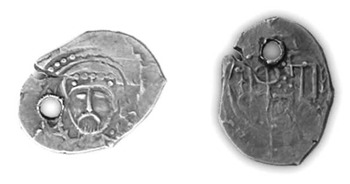



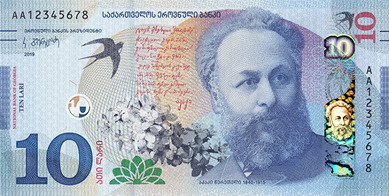

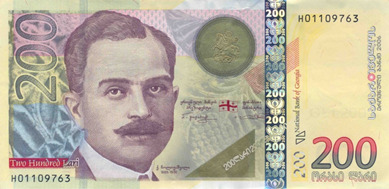
0 notes
Text
NATO’s Future Eastern Frontier: Historical Pattern
Tedo Dundua
NATO’s Eastern frontier is stretched from the Baltic Sea to the Western shores of the Black Sea. When aspirant countries, namely, Ukraine and Georgia, in the Alliance, political map will be more accurate from historical point of view. Indeed, in the 10th c. Eastern frontier of the “Byzantine Commonwealth” was fixed along Eastern (Georgia) and Northern shores of the Black Sea, the Dnieper River (Kyivan Rus), towards the Baltic Sea. Georgia, old ally of Byzantium, had good relations with Commonwealth’s newly added states. Those links are well attested by findings of the Georgian coins.
The initiator of the Georgian coinage inspired by Byzantine style was David III Kuropalates, seignior of Imier Tao, a part of historical Southwestern Georgia. Below we have his silver coin with cross potent and Georgian legends (inscription), issued in 979.
Only four specimens are known from this emission.
From the 4 specimens now discussed none of them was found in Georgia. They were discovered far away from there, in Russia, Estonia, Germany and Sweden (Near St. Petersburg, place Lodeinoe Pole, Russia; place Völlja, Estonia; Mecklenburg-Schwerin, place Schwaan, Germany; Gotland, Dalhem, Hallfose II, Sweden. Р. В. Кебуладзе, В. М. Потин. Монеты Давида Курапалата в кладах западноевропейских денариев. Matsne (Historical issue). 1970. №2. Tbilisi; Corpus Nummorum Saeculorum IX-XI, qui in Suecia Reperti Sunt. Catalogue of Coins from 9th-11th Centuries Found in Sweden. 1. Gotland. 3. Dalhem-Etelhem. Stockholm. 1982, p. 5, pl. I, 2:12). How did they find their way to those regions? Two hypotheses exist concerning this item:
1) Typologically these coins are very close to almost synchronous Byzantine silver pieces of Basil II (976-1025) and Constantine VIII, and they have the same weight and standard. So it was good money and could circulate everywhere together with Byzantine currency. Merchants from Kyiv used to come to Constantinople regularly and then they took the silver pieces of David Kuropalates to Europe
2) Trading contacts between Georgia and Kyivan Rus must account for the findings of these coins on the territory of Europe, effected via Tmutaracan (modern Taman Peninsula), this view being corroborated by other evidence as well. A rare Tmutaracanian piece was found in Georgia – the imitation of Byzantine silver money (Р. В. Кебуладзе, В. М. Потин. Монеты Давида Курапалата в кладах западноевропейских денариев, p. 219).

http://geonumismatics.tsu.ge/en/catalogue/types/?type=40;
Tedo Dundua. History of Georgia. Tbilisi. 2017, pp. 176-190 https://www.academia.edu/35768659/History_of_Georgia
0 notes
Text
Political Emigrants from Crimea: Past and Present
Tedo Dundua
Crimea is occupied by the Russians, and Georgia has many Ukrainian political emigrants. Political emigrants from Crimea were present in Western Georgia/Colchis also in Antiquity. The story below is about it.
We are focused on small size copper, billon, and silver coins, eight samples in all (so-called Saulaces’ coins).
I type.
Obverse: Male head to the right in the radiant crown. Reverse: Bull’s head to the right. Greek inscription above and below – ΒΑΣΙ... ΣΑΥΛ or ΣΑΥΜ... meaning “of king Saulaces”, or “Saumakos“. The king’s name is only partially inscribed with the last letter read either “Λ”, or “Μ”.
II type. Obv. Male head to the right in the radiant crown. Rev. Rose, Greek inscription above and below – ΒΑΣΙΛΕ... ΣΑΥΛ or ΣΑΥΜ... meaning “of king Saulaces”, or “Saumakos”.
III type. Obv. Male head facing in radiant crown. Rev. Winged thunderbolt with Greek inscription above and below – ΒΑΣΙ... ΣΑΥ...
As we see, none of the coins has a full inscription of the king’s name. This fact generated discussions lasting for more than a century. Doubtful is the fourth letter of the king’s name on the reverse of the coin. Some scholars read it as “Λ”, and therefore, the inscription is deciphered as ΒΑΣΙΛΕΩΣ ΣΑΥΛ(ΑΚΟΥ) – “of king Saulaces“, since the latter name appears among the names of the Colchian kings. Other scholars read the fourth letter as “Μ”. Thus, according to this group of scholars, the name on the coin should be read as ΒΑΣΙΛΕΩΣ ΣΑΥΜ(ΑΚΟΥ) – “of king Saumakos”, since such a king is known in the history of the kingdom of Bosphorus (in Eastern Crimea).
On the II type of these coins a rose is depicted which allows us to date approximately the whole coin group. This type is taken from the Rhodean numismatics. The rose-depicted coin is the exact copy of those Rhodean coins struck in 166-88 B.C. This, in turn, allows us to date those discussed samples by 2nd-1st cc. B.C. Fact is that 5 samples out of 8 were found in Western Georgia (near Sokhumi and in Vani). Some scholars relate the above-given coins to the kingdom of Bosphorus. Their argument is as follows: as was mentioned above, rose type is taken from the Rhodean money, struck in 166-88 B.C. Thus, these coins should be dated by 2nd-1st cc. B.C. The only historical figure attested by the written sources is Saumakos. He is mentioned in the decree set up in Chersonesus (in Southwestern Crimea) in honor of Diophantos (general of Mithridates VI Eupator, king of Pontus (120-63 B.C.)). Saumakos organized a coup d’état in the kingdom of Bosphorus in the last decade of the 2nd c. B.C. and reigned over it for a short period of time. Presumably, he struck these coins during this period. In 107 B.C. he was defeated and taken prisoner by the above-mentioned Diophantos. Considering the given facts, these coins can be attributed to the numismatics of the kingdom of Bosphorus. Very likely, they were brought to Colchis by the supporters of Saumakos, who had to leave the country, i.e. by political emigrants.
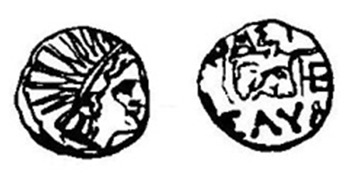
http://geonumismatics.tsu.ge/en/catalogue/types/?type=19
0 notes
Text
Non-dominant Languages for Imperial Coins: Greek and Georgian Cases
Tedo Dundua
In the Roman Empire, with Latin as official language, nationalist spirit of illustrious Greeks was respected by issue of some Imperial coins with the Greek legends (inscriptions). Caesarea in Hellenistic Cappadocia was large and very important Imperial mint, which struck such money for a long time.
Same gesture towards Georgians, the most ancient Orthodox people, was Russian token and it did not last long.
At the beginning of the 19th c. Kartalino-Kakhetian Kingdom (Eastern Georgia) became a part of the Russian Empire. Old Tbilisi mint was closed. But this measure created a problem – shortage of silver and copper coins. The money sent from Russia could not fill up the gap, it was coming slowly. Administration and courts were paid in assignations and chervonetsy – Dutch ducats, called lobanchiks. Army needed even more money to buy local supplies. And the local population neglected assignations even firmly seeing how the taxes were collected in old silver money. Scarcity of silver lowered the rate of Russian gold coin, which was quite high in other places. Merchants had good profit thanks to low exchange rate of gold, and the prices rushed high. Cheap Iranian goods flooded Georgian market taking back coins, thus making crisis more severe.
The situation was to be changed. Preparations were made for reorganization of old Tbilisi mint, now under the Russian control. They decided that future coin, with ostensible Georgian features, would be struck according to Russian monetary system. Tsar Alexander I ordered “to put nothing Russian” on the Georgian coins. On September 15, 1804 there was the mint inaugurated in former royal bath celebrated by issue of commemorative medal.
Russian government imposed unified type for silver and copper coins struck at Tbilisi.
Obverse: Crown, palm and olive branches. Georgian legend – Tbilisi. Reverse: Georgian legend – 400 (nominal)/Georgian/tetri (silver)/1804. Russian legend, initials of die-engraver.
Silver coins were struck at Tbilisi in 1804-1834 and copper coins – in 1804-1810. Tbilisi mint was functioning until 1834.

http://geonumismatics.tsu.ge/en/catalogue/types/?type=120
0 notes
Text
Georgia through the Asian Eyes. Event in History
Tedo Dundua
Georgia, commercial bridge to Asia, has always been respected in neighbours. Georgia made her European choice in Classical Antiquity as Colchians (Western Georgians) invited the Greeks to colonize their country, and Iberian (Eastern Georgian) kings became Roman citizens. Asian neighbouring confederations had different opinion about Georgia’s political affiliation. Whenever possible, they used to exercise their rule over the country, still respecting her. The case of Mongols is narrated below.
Mongol hegemony was established over Georgia in the midst of the 13th c. The coins struck at Tbilisi mint are divided into two groups: 1. coins of the Georgian kings in the 13th-14th cc., 2. Mongol occupation coins. For the moment, we will discuss only the Mongol occupation coins.
In 1281/82 begins issue of very peculiar dirhems, which in the scholarly literature are known as the Georgian-Hulaguid (Mongol ruling dynasty in Iran) coins. They were the first coins with the names of the Il-khans (Mongol rulers of Iran), but, with the Christian prayer and the depiction of cross. It should be emphasized that Georgia was the only Hulaguid vassal-state where the Christian prayer was placed on the coins. This, in itself, was a big concession from the Il-khans which directly attests to the importance of Georgia. The issue of the Georgian-Hulaguid coins took place in 1281/82-1294/95. As a rule, there was no place of issue indicated on the Georgian-Hulaguid coins, but there is one dirhem with the following legend: struck at Tbilisi.
Georgian-Hulaguid coins. Silver (dirhem). Copper. Obverse: Uighur legend in five lines which contains the names of the following Il-khans: Abaqa (1265-1282), Ahmad (1282-1284), Arghun (1284-1291), Gaikhatu (1291-1295) and Baidu (1295) (the legend/inscription is approximately as follows: Struck by Ahmad in the name of Khaqan). Reverse: Christian prayer in Arabic in four lines in square within the circle – In the name of the Father, and the Son and the Holy Spirit, One God. Also, Christian emblem – cross. The date is placed in the segments between the square and the circle.
It is noteworthy that on the dirhems struck in the name of Ahmad the cross is replaced with a star. This can be explained. Ahmad was the first from the Hulaguids who converted to Islam and was intent on removing the Christian symbol, cross, from the coins. After this, the names of the Il-khans are repeated in Arabic after the Uighur legend. The cross is again depicted on the Georgian-Hulaguid coins struck in the name of Ahmad’s successors. Simultaneously with the silver coins, also similar copper coins were struck. The dates on these coins are almost always distorted, or erased, and their chronology is established only through the names of the Il-khans

http://geonumismatics.tsu.ge/en/catalogue/types/?type=94
0 notes
Text
Imitations of the Roman Coins in “Transcaucasian” States
Tedo Dundua, Natia Phiphia
There were four states in Classical Antiquity Southwards from the Caucasian Range and Eastwards from the Black Sea: Colchis/Lazica (modern West Georgia), Kartli/Iberia (modern East and South Georgia), Albania (modern Azerbaijan) and Armenia. All of them, more or less influenced by the Roman Empire, had Roman money in circulation. Provincial silver of Caesareian issue, denarii struck in greater quantity by Eastern, e.g. Syrian mints, municipal copper of Trapezus and Imperial copper money, struck predominantly at the mints of Antioch and Asia Minor, circulated in Lazica. In its Eastern provinces Caesareian issues were mixed with denarii of Augustus and late Roman gold imported from Iberia http://geonumismatics.tsu.ge/en/catalogue/types/?type=26. Aurei and Augustan denarii formed a bulk of the money in circulation in Iberia. Then they were imitated http://geonumismatics.tsu.ge/en/catalogue/types/?type=28. Now in details, first, the empiric level.
1) Imitation of Philip I’s aureus. GF. (Fund of Treasury, Numismatic Collection, Simon Janashia Museum of Georgia) №9156. Weight – 4 gr. From Armazi necropolis (East Georgia).
Obverse: Bust of Philip I, laureate, cuirassed, r. Legend IMP M IVL PHILIPPVS AVG distorted.
Reverse: Mars standing l., holds spear in r. hand, l. hand rests on a round shield. Distorted legend. If this is ANNOI (ANNONA), yet another prototype was used.
2) Imitation of Philip I’s aureus. GF. (Fund of Treasury, Numismatic Collection, Simon Janashia Museum of Georgia) №9155. Weight – 3,45 gr. From Armazi necropolis (East Georgia). (1) and (2) are struck by the same dies.
3) Imitation of Philip I’s aureus. GF. (Fund of Treasury, Numismatic Collection, Simon Janashia Museum of Georgia) №12181. Weight – 3,87 gr. From Maghraneti necropolis (East Georgia). The same dies were used.
4) Imitation of Trajan Decius’ aureus. GF. (Fund of Treasury, Numismatic Collection, Simon Janashia Museum of Georgia) №9158. Weight – 3,73 gr. From Armazi necropolis (East Georgia).
Obverse: Bust of Trajan Decius, radiate, draped, r. Distorted legend, still ANVS DEC is well traced.
Reverse: Concordia standing l., sacrificing out of patera in r. hand at altar and holding cornucopiae in l. hand. CONCORDIAE EXERCITI slightly distorted.
5) Imitation of Hostilian’s aureus. GF. (Fund of Treasury, Numismatic Collection, Simon Janashia Museum of Georgia) №9157. Weight – 4,8 gr. From Armazi necropolis (East Georgia).
Obverse: Bust of Hostilian, laureate, r. Distorted legend. Scholars mostly see the name of Hostilian.
Reverse: Annona standing l., holds corn-ears and cornucopiae. Distorted legend.
6) Imitation of Valerian I’s aureus. GF. (Fund of Treasury, Numismatic Collection, Simon Janashia Museum of Georgia) №9735. Weight – 3,51 gr. Vashlovani (East Georgia).
Obverse: Bust of Emperor, laureate, r. Illegible legend.
Reverse: Victoria driving biga l. Illegible legend.
7) Imitation of Valerian I’s aureus. Azerbaijan State Museum of History. Weight – 3,64 gr. Place of finding is unknown.
Obverse: Bust of Emperor, laureate, cuirassed, r. Distorted legend.
Reverse: Victoria driving biga r. Distorted legend.
8) Imitation of Valerian I’s aureus. GF. (Fund of Treasury, Numismatic Collection, Simon Janashia Museum of Georgia) №14595. Weight – 3,63 gr. From Jinvali (East Georgia) burial (together with original coin).
Obverse: Bust of Emperor, laureate, r. Mirror image of inscription IMP C P LIC VALERIANVS AVG.
Reverse: Victoria driving biga l. Mirror image of VICTORI AVCC.
9) Imitation of Valerian I’s aureus. GF. (Fund of Treasury, Numismatic Collection, Simon Janashia Museum of Georgia) №9151. Weight – 3,44 gr. From Armaziskhevi tomb (East Georgia).
Obverse: Bust of Emperor, laureate, r. Illegible legend.
Reverse: Victoria driving biga l. Almost illegible legend, still VI is well traced.
10) Imitation of Numerian’s aureus. GF. (Fund of Treasury, Numismatic Collection, Simon Janashia Museum of Georgia) №9340. Weight – 3,52 gr. From Aghaiani burial (East Georgia).
Obverse: Bust of Emperor, laureate, l. Mirror image of inscription, of which first letters IMP C are quite clear.
Reverse: Victoria advancing l., holding wreath. Mirror image of inscription VICTORII V AVGG.
11) Imitation of Numerian’s aureus. GF. (Fund of Treasury, Numismatic Collection, Simon Janashia Museum of Georgia) №9336. Weight – 2,68 gr. From Tskhinvali burial (East Georgia). (10) and (11) are struck by the same dies.
The midst of the 1st c. A.D. was a final stage of issue of Georgian imitations of Alexander and Lysimachus’ type staters. After a gap of two centuries, Iberia renewed emission of imitations. The same dies for imitations above (№№1-3, 10-11), imitation (№8) found together with its prototype, i.e. original coin, speak about local origin of mentioned gold coins. Chronology of existence of this phenomenon, according to the burials and prototypes, seems to be roughly second half of the 3rd c. This statement can be argued because of data below.
12) Imitation of Augustus’ aureus. GF. (Fund of Treasury, Numismatic Collection, Simon Janashia Museum of Georgia) №12215. Weight – 3,52 gr. From Simoniant-khevi burial (East Georgia).
Obverse: Head of Emperor, laureate, crude in style, r. Latin inscription CAESAR AVGVSTVS DIVI F. PATER PATRIAE distorted.
Reverse: Gaius and Lucius Caesars, standing front, each with a hand resting on a round shield. Spears behind the shields. Incuse instead of simpulum and lituus above. Latin legend C. L. CAESARES AVGVSTI F COS DESIG PRINC IVVENT – mirror image and distorted.
13) Imitation of Augustus’ aureus. GF. (Fund of Treasury, Numismatic Collection, Simon Janashia Museum of Georgia) №14596. Weight – 2,87 gr. From Jinvali burial (East Georgia). (12) and (13) are struck by the same dies.
14) Imitation of Commodus’ aureus (hybrid). GF. (Fund of Treasury, Numismatic Collection, Simon Janashia Museum of Georgia) №12179. Weight – 3,10 gr. From Maghraneti burial (East Georgia).
Obverse: Bust of Commodus, laureate, draped, r. Name of Emperor is clearly seen.
Reverse: Head of Emperor, laureate, crude in style, r. Latin inscription CAESAR AVGVSTVS DIVI F. PATER PATRIAE distorted.
Obverse die of above Augustan imitations served as a reverse die for this hybrid, found in Maghraneti burial together with the coins of Severus Alexander and Carus. So, one can suggest again 3rd c. as a date of all these imitations.
15) Imitation of aureus (hybrid/Lucilla, Severus Alexander, Gordian III). GF. (Fund of Treasury, Numismatic Collection, Simon Janashia Museum of Georgia) №9333. Weight – 6,43 gr. From Ureki burial (West Georgia).
Obverse: Female bust r. Distorted legend still contains LUCILLAE.
Reverse: Mars with spear advancing l. Legend IOVI CONSERVATORI (!) distorted. Other prototypes were also used.
16) One identical piece comes from the site of Photi (West Georgia).
17) Imitations of Augustus’ denarius. GF. (Fund of Treasury, Numismatic Collection, Simon Janashia Museum of Georgia) №№2544, 5103, 9446; QF. (Main Fund of the Georgian Coins, Numismatic Collection, Simon Janashia Museum of Georgia) №№54, 1704, 1705, 3372, 3425, 4049, 4050, 4051, 4052, 4053, 4054; Numismatic Fund, History Museum of Armenia, Yerevan – №14362; Pushkin State Museum of Fine Arts, Moscow – 1 sample. The weights range from 1,28 to 3,55 gr. Places of finding are mostly unknown.
Obverse: Head of Emperor, laureate, crude in style, r./l. Latin inscription CAESAR AVGVSTVS DIVI F. PATER PATRIAE distorted.
Reverse: Gaius and Lucius Caesars, standing front, each with a hand resting on a round shield. Spears behind the shields. Simpulum and lituus above the shields. Latin legend C. L. CAESARES AVGUSTI F COS DESIG PRINC IVVENT distorted.
Hybrid.
Obverse: Head of Emperor, laureate, r. Distorted Latin legend suggests Marcus Aurelius’ issue as a prototype.
Reverse: Gaius and Lucius Caesars, standing front, each with a hand resting on a round shield. Spears behind the shields. Latin legend distorted.
Even 3rd c. burials from East Georgia show Augustan denarii, while most of their imitations at Numismatic Collection, Simon Janashia Museum of Georgia, are without proper indication about place of finding. Some of the imitations were found in the complexes (2 samples in West Georgia, 4 – in East Georgia), which cannot be dated precisely. Still, general consideration leads to the conclusion that, together with the imitations of aurei, imitations of Augustan denarius were produced locally in the second half of the 3rd c.
Aurei and Augustan denarii formed a bulk of the money in circulation in Iberia, other debased denarii were, in fact, ignored – a situation quite similar to that in the Roman Orient for some time. If we confront this data with Syrian imports discovered in Georgia, one can suggest that the Syrian provincial treasury was the source of supply for Iberia. A severe Imperial crisis of the 3rd c. limited this supply. Even if it did not, Iberia would have bartered the Roman money no more. Transformation of the country towards Feudalism needed a supply different than money. The country’s stocks of precious metal could be exhausted to support the general reform – the strengthening in number of the upper classes meant a gradual conversion of some yeomanry from farmers to high-level administrators. Food-shortages could happen, and large-scale food supply was necessary. Industry suffered also as some of the artisans had to earn living doing agricultural jobs. The amount of industrial goods per capita was quickly diminishing, thus creating a demand for small-scale local debased issues with the king as the only potential power to strike these coins.
As mentioned before, there is one sample of Augustan imitation kept at Numismatic Fund, History Museum of Armenia, Yerevan, and imitation of Valerian I’s aureus is kept at Azerbaijan State Museum of History. In both cases, place of finding is unknown. So, nothing can be said. Still, it seems that there were no local imitations of the Roman coins circulating in Armenia and Albania (modern Azerbaijan).
Not surprisingly, the most faithful Roman ally in the region, Iberia, had the most Roman “numismatic visage”.










0 notes
Text
Georgian and European Armies in Action
Georgia, an aspirant for NATO membership, actively contributes to NATO-led operations. Georgia’s alliance with the West has its historical background. General chronology of the Crusades shows well-coordinated warfare.
1085
Alfonso VI, king of Castile, took Toledo. The center of Arab science and learning fell into Christian hands.
1086
The Almoravid army in Spain defeated Alfonso VI of Castile’s army at Zallaka.
1087
Genoa and Pisa took control of the Western Mediterranean from the Arabs.
1089
David IV, son of Giorgi II, ascended the Georgian throne.
1091
Duke Roger completed his conquest of Sicily and went on to take Malta.
1094
Castilian soldier Ruy Diaz de Bivar, better known as El Cid, took Valencia after a nine-month siege.
1095
The Byzantine Emperor Alexios requested aid against Seljuks. Pope Urban proclaimed the Crusade at the Synod of Clermont.
1096
Alexios Comnenos provided food and escort for the Crusaders, exacting an oath of fealty from the leaders in an attempt to protect his rights over any “lost provinces” of Byzantine Empire.
1097
Battle of Nicaea: a combined force of Crusaders and the Byzantines took the Turks’ capital.
1098
After a nine-month siege by Bohemund of Taranto, Antioch fell to the Crusaders.
1099
El Cid was defeated by the Almoravids at Cuenca and died. Jerusalem fell to the Crusaders. Kingdom of Jerusalem was founded under the Norman knight Godfrey de Bouillon. He was elected king and assumed the title of Defender of the Holy Sepulchre. On hearing that Jerusalem fell to Christians, David IV of Georgia refused to pay tribute to Seljuks. He began a war against them.
1102
Alfonso VI lifted the Almoravids’ siege of Valencia, he emptied and burned the city.
1104
Baldwin I of Jerusalem took Acre, Raymond of Toulouse took Byblos.
1105
Battle of Ertsukhi, Georgians defeated the Turks.
1109
Crusaders took Tripoli and Beirut.
1113
The knights of the Hospital of St. John resolved to fight for the defense of the Holy Land.
1114
Toledo withstood an attack by the Almoravids.
1118
Alfonso of Aragon retook Saragossa from the Almoravids, and made the town his capital. King David IV of Georgia invited Cumans as settlers to form a light cavalry.
1121
The Byzantine Emperor John II Comnenos took Southwest Anatolia back from Turks. In the battle of Didgori David IV, with his Georgians and some 200 crusaders in the army, attacked the Seljuks more than twice as much in size. Turks were decisively defeated.
1122
David’s army retook Tbilisi. Muslim rule was brought to end.
1124
David IV of Georgia invaded Armenia and Shirvan to exercise Georgian rule instead of Turkish.
1139
Demetre I of Georgia took Ganja in Azerbaijan.
1144
Zangi sultan of Mosul took Edessa after conquering Muslim Northern Syria.This prompted calls for another Crusade.
1145
Almoravid rulers lost their hold over Spain.
1147
The Second Crusade began under leadership of Louis VII of France and Conrad III, but there was no overall command.
1153
Baldwin III king of Jerusalem took Ascalon, the last remaining Fatimid possession in the Holy land.
1154
Damascus surrendered to the sultan of Aleppo.
1163
Georgia’s victory over the Turks of Erzerum.
1169
Salah ed-Din became vizier of the Fatimid Caliph of Cairo. As vizier, Salah ed-Din held more real power than the Caliph, who was mainly a ceremonial figure.
1171
Salah ed-Din abolished the Caliphate, becoming effective sovereign of Egypt.
1172
Georgians were victorious near the Armenian city of Dvin.
1173
Salah ed-Din seized Aden. Giorgi, king of the Georgians, attacked Derbend. He was accom- panied by his close friend and relative Andronicos Comnenos, future Emperor.
1175
Salah ed-Din gradually welded Egypt and Syria into a single pan-Arab power, with serious implications for the Holy Land in the middle. Salah ed-Din planned to take the Holy Land for himself.
1176
Salah ed-Din mounted a campaign to drive Christians from the kingdom of Jerusalem.
1177
Salah ed-Din was defeated by Baldwin IV of Jerusalem at Ramleh.
1183
Salah ed-Din conquered Syria, took Aleppo and became sultan.
1185
Salah ed-Din seized Mosul and began his conquest of Mesopotamia.
1186
Frederick Barbarossa started to prepare for the Third Crusade.
1187
Salah ed-Din took Jerusalem.
1188
Philip II of France imposed a Salah ed-Din tithe to raise money for the Third Crusade.
1190
The Holy Roman Emperor Frederick Barbarossa drowned in the river Calycadnus in Cilicia. Philip II started to prepare to join the Crusade.
1191
Richard I of England embarked on the Third Crusade but spent a winter quarrelling with Philip II in Sicily. Then he left Messina and conquered Cyprus. Richard joined the siege of Acre and played a major part in reducing Acre. Philip II fell ill and returned to Paris. Richard meanwhile gained a victory over Salah ed-Din at Arsuf and led the Crusaders to within a few miles of Jerusalem.
1192
The Crusaders followed unreliable and dishonest guides into the desert. Famine, disease and desertion reduced their numbers. Richard I made a truce with Salah ed-Din. Under it the Christians were allowed to keep the ports they had taken and have unrestricted access to the Holy Sepulchre in Jerusalem.
1195
Georgians defeated the Turks in the battle of Shamkhori.
1202
Pope Innocent III offered the command of the Fourth Crusade to Boniface III, count of Montferrat. Battle of Basiani – Georgians faced the sultan of Rum Rukn ad-Din, Turks were defeated.
0 notes
Text
St. George’s Iconography. Georgian Contribution to the Western Civilization
Tedo Dundua
“Good Defeats Evil” is a sculpture at the United Nations Headquarter in New York, presented in 1990, on occasion of the 45th anniversary of the United Nations. St. George is slaying dragon, and dragon is created from fragments of Soviet and US missiles destroyed under the special treaty. Georgia’s Zurab Tsereteli created it. This liaison between UN, St. George and Georgian artist is quite amusing. Indeed, they were the Georgians to introduce St. George’s classical iconography. Below is history.
An interesting site should be discussed – this is bilingual (Graeco-Colchian, populated by West Georgian people) Trapezus, with a special confessional visage. Élite of Trapezus worshiped Mithras, god of the sun and light, young and just. Mithras was abstracted from the late Iranian Zoroastrianism, and definitely changed in Graeco-Roman world. Mithras on municipal coinage of Trapezus (2nd-3rd cc. Name of Roman Emperor on obverse, name of community on reverse) seems to be beyond the traditional scheme. In the very heart of Empire Mithras is always pedestrian; here, in Trapezus, Mithras, fellow in a radiant Phrygian cap, is a horseman accompanied by a snake. Horseman with a spear is already St. George; i.e. Mithras from Trapezus is to be regarded as a prototype of St. George’s iconography. Trapezus enjoyed this very special deity – local synthesis of Mithras and Cappadocian Men (lunar god), young equestrian in a radiant Phrygian cap.
We need to follow evolution of Mithras’ effigy on the coins of Trapezus. At first, Mithras’ bust in radiant Phrygian cap is depicted on them. Then protome of horse was added. Three samples of Trapezus’ coins found in Bichvinta/Pitsunda (Western Georgia) have fantastic illustration: stylized effigy of enthroned horse, linked with Mithras. Such is Mithras on the 2nd c. coins. And from the end of the 2nd c. Mithras is already equestrian, sometimes with companions, and sometimes with snake below. http://geonumismatics.tsu.ge/en/catalogue/types/?type=26
There is opinion that the equestrian on municipal copper coins of Trapezus is not actually Mithras, but syncretic deity, which united the functions of Mithras and Men, Cappadocian lunar deity. Indeed, Mithras is rarely depicted as equestrian, while this is common for Men. In scientific literature nine gems are known up today with Mithras depicted in the same pose, as it is on municipal copper coins of Trapezus. Out of nine gems with identical depiction eight are discovered in Georgia (7 – in Eastern Georgia and 1 – in Western Georgia). Ninth gem (Berlin Museum) could be produced either in Trapezus, or in Colchis /Lazica (Western Georgia) and Iberia (Eastern Georgia). So, municipal copper coins of Trapezus with the effigy of Mithras have parallel in synchronous gems found (or made) in Georgia. They had the same deity.
Perhaps, deity depicted on municipal copper coins of Trapezus and on the gems found in Georgia is the pagan god who was replaced by Saint George.
The earliest depictions of Saint George equestrian come from Georgia. Two steles of Saint George equestrian found in Eastern Georgia (Aghik and Burdadzor, Marneuli district) are kept in Shalva Amiranashvili Museum of Fine Arts, Tbilisi. Saint George equestrian killing a dragon is depicted on Burdadzor stele together with the astral signs (the sun, the moon, a star). The moon is represented as bull’s head, having crescent-shaped horns. Link between municipal copper coins of Trapezus and the steles is obvious. The steles are the next step of development.
After, this iconography spread all over the Christian world.


0 notes
Text
Muslim Religious Formulas on Money of Georgian Christian Monarchs
Tedo Dundua
The title sounds a bit strange, but still it fits reality, created either by political, or economic demands. Data is presented below.
Half drama of Bagrat III (975-1014), imitation to dirhem.
Obverse: Central Arabic legend in three lines – “There is no god but Allāh alone, he has no associate”. Distorted Arabic legend around.
Reverse: Central Arabic legend – “Muhammad is the Messenger of Allāh”. Georgian Asomtavruli legend in abbreviation around it – “Christ, exalt Bagrat, king of the Abkhasians (Western Georgia)”.
http://geonumismatics.tsu.ge/en/catalogue/types/?type=39
Copper coins of Vakhtang III (1297-1308) with the monograms.
Obverse: Arabic legend in three lines – “The most mighty king, Ghazan Mahmud, may God perpetuate his reign”. Under the third line two Georgian Asomtavruli monograms which are read as “king Vakhtang”.
Reverse: Area in square within circle of the dots and Arabic legend in three lines – “There is no god, but Allāh alone, he has no associate”.
Obverse: Arabic legend in four lines – “The most mighty sultan, Ghiyath al-Dunya wa’l-Din, Khudabandeh Muhammad, may God perpetuate his reign”. The legend is placed within a linear square. Out, an unreadable inscription.
Reverse: Arabic legend in four lines –“There is no god, but Allāh alone, Muhammad is the Messenger of Allāh”. Below the monogram composed of three Asomtavruli letters, “Vakhtang”.
http://geonumismatics.tsu.ge/en/catalogue/types/?type=58
Coins of Giorgi VII (1393-1407) with the “depiction of an open eye”.
Obverse: Large dot in the center. Unreadable signs to both sides of it, which more resemble the inverted formula “to the god” in Arabic. This, placed within the pointed oval, creates a figure of a man’s open eye. At the ends of the coin, Georgian Asomtavruli legend – “King of the Kings Giorgi”.
Reverse: Distorted Arabic legend (Sunni religious formula).
Obverse: Man’s open eye. Large Asomtavruli letters in the center – “king”. Outside the frame waving lines and several dots.
Reverse: Distorted Arabic legend in three lines (Sunni religious formula).
Obverse: Large dot in the center with each dot to both sides of it, all placed within pointed oval. Waving lines and each dot at the top and the bottom. All this placed within double circle, one border of dots, another – linear.
Reverse: Distorted Arabic legend in three lines (Sunni religious formula) placed within the identical circles as on the obverse.
http://geonumismatics.tsu.ge/en/catalogue/types/?type=59
Silver coins of Giorgi VII and Ahmad Jalā’ir.
Obverse: Arabic legend in four lines – “Sultan Ahmad, may his reign be perpetuated, victorious king Giorgi. Struck at Tbilisi”. Reverse: Arabic legend within double linear square, with the linear circle and the circle of the dots around it: “There is no god but Allāh alone, Muhammad is the Messenger of Allāh”. Between the square and circle name of the four Caliphs.
http://geonumismatics.tsu.ge/en/catalogue/types/?type=60
Silver coins of Erekle II (1745-1798).
Obverse: Persian legend – “Praise be to Allāh, lord of two worlds”. Flower ornaments. Linear circle, first, then – circle of the dots.
Reverse: Persian legends: “O gracious”. “Struck at Tbilisi in 1194 (=1780)”. Figural frame, then – linear circle and circle of the dots.
http://geonumismatics.tsu.ge/en/catalogue/types/?type=119

0 notes
Text
About Political Prestige of Georgia
Tedo Dundua
Nino Silagadze
Georgia faces enormous challenges as a tiny country with limited resources, and some regional problems. Still, the Georgian people have a supreme power. They choose their leaders to represent them. And business people decide what to produce. For the special achievements in democracy building Georgia has high political prestige. While a decline in the 16th c, with the Georgian kings still guarding the “Christian” frontier, political prestige of the country was also high. The story below is about it.
Fetiyecamii is architectural celebrity of Istanbul, and beloved place for the tourists. The Turkish term seems to be the 16th c. label for the church of the Virgin Pammacaristos, turned into a mosque by that times (S. Runciman. The Fall of Constantinople 1453. Cambridge. 1965. Reprinted 1996, p. 201).
By well established Ottoman tradition, if a city surrendered of its own will to them, the Christians could retain their churches, otherwise they were to be converted into a mosque (S. Runciman. The Fall of Constantinople 1453, pp. 145, 199).
Constantinople fell on 29 May 1453. When the news spread that the land-walls had been breached, some isolated quarters of the city, possessing their own wall, surrendered at once. This legal evidence, together with some pragmatic issues – now sultan was also emperor of the Greeks – helped milet, a self-governing Greek community within the Ottoman Empire, to keep some of the churches in Constantinople (S. Runciman. The Fall of Constantinople 1453, pp. 202-204; J. J. Norwich. A Short History of Byzantium. Published in Penguin Books. 1998, pp. 375-381).
The Pammacaristos was to be the Patriarchal church for more a century with a Patriarch residing there as a head of milet ( S. Runciman. The Fall of Constantinople 1453, pp. 200-201). As the most prominent Orthodox shrine, it had been under a permanent pressure of sultan, being either badly enraged, or – extremely happy, does not matter.
For Murad III in 1586 the both feelings are present and vivid – former, because that was not real victory over invincible Simon, the king of Kartli (East Georgia), and latter, because the fortresses in Georgia had been recaptured, and Ottoman garrisons – strengthened basically (Studies in History of Georgia (in Georg.). v. IV. Tb. 1973, p. 138 and n. 4; for the last phase of the war v. D. Cantemir. History of the Othman Empire (transl. N. Tindal). London. 1734, pp. 233-34). Later in 1600 Simon’s capture was followed by three days festival all-over Empire (Studies in History of Georgia. v. IV, p. 149), and now Murad III annexed the Pammacaristos as he celebrated his victory over the infidels (R. Janin. La Géographie Ecclésiastique de L’Empire Byzantin. Première Partie. La Siège de Constantinople et le Patriarcat Oecuménique. t. III. Les Églises et les Monastères. II Edition. Paris. 1969, p. 210).
Simon was to blame for a loss of residence for the Greek Patriarch. He was, indeed, a superb warrior.
But only within what could be still called Byzantium, legacy of which they claimed for themselves, the Ottomans insisted the churches should at once be transformed into a mosque. It seems a bit strange how one could bind Simon the Georgian with Pammacaristos. We have to look at Mehmet the Conqueror titled both as emperor and sultan on the famous Western-manufactured medal of 1481 to make things clear. Sultan is basileus and he needs his “Byzantine Commonwealth”, thus humiliating Serbs and Bulgarians and stripping them from Tsar-claim. In the eyes of the Ottomans, with Georgians being defeated, “Byzantine Commonwealth” was already theirs and with the Pammacaristos confiscated, that was already styled upon the crescent.
0 notes